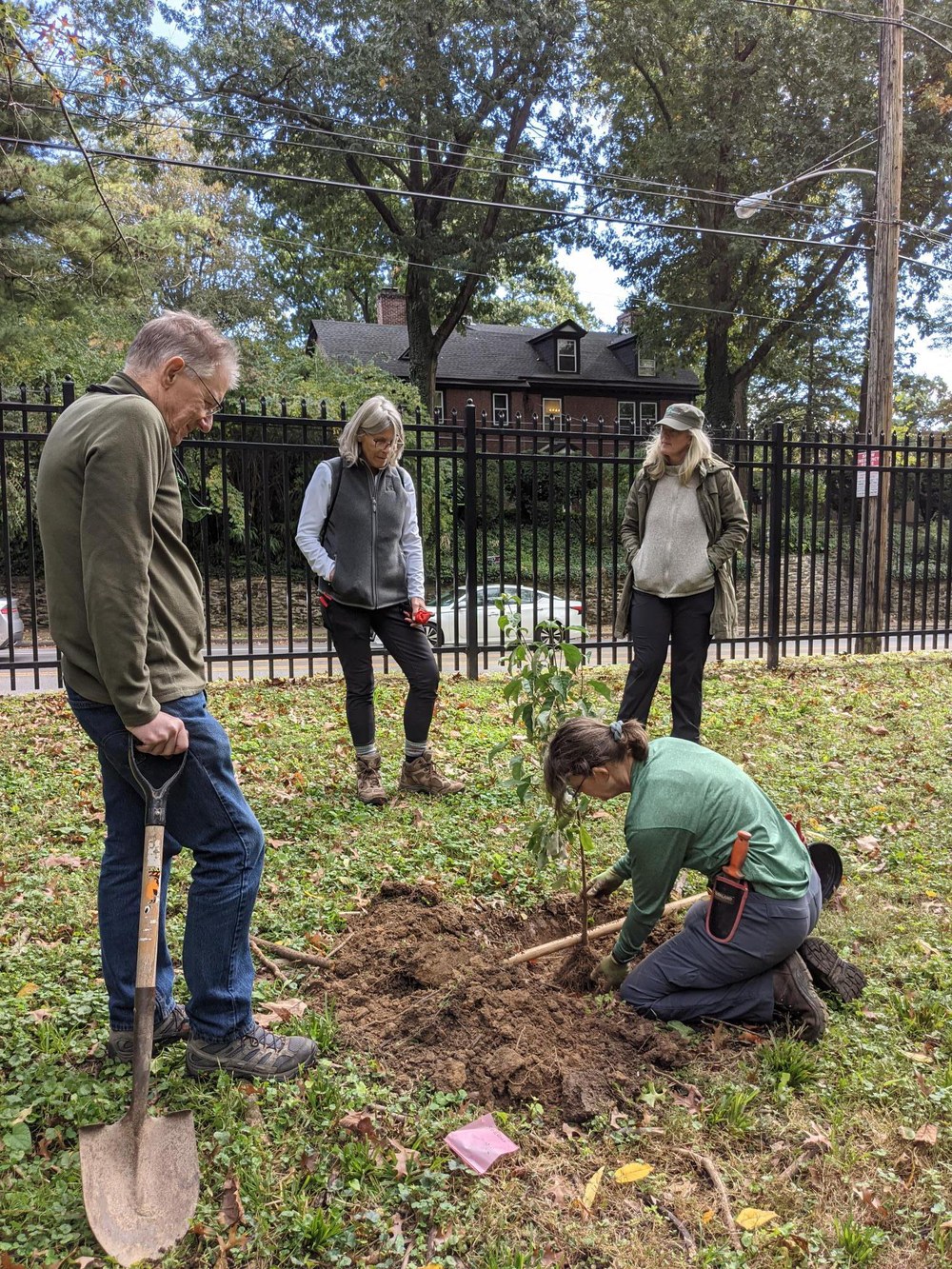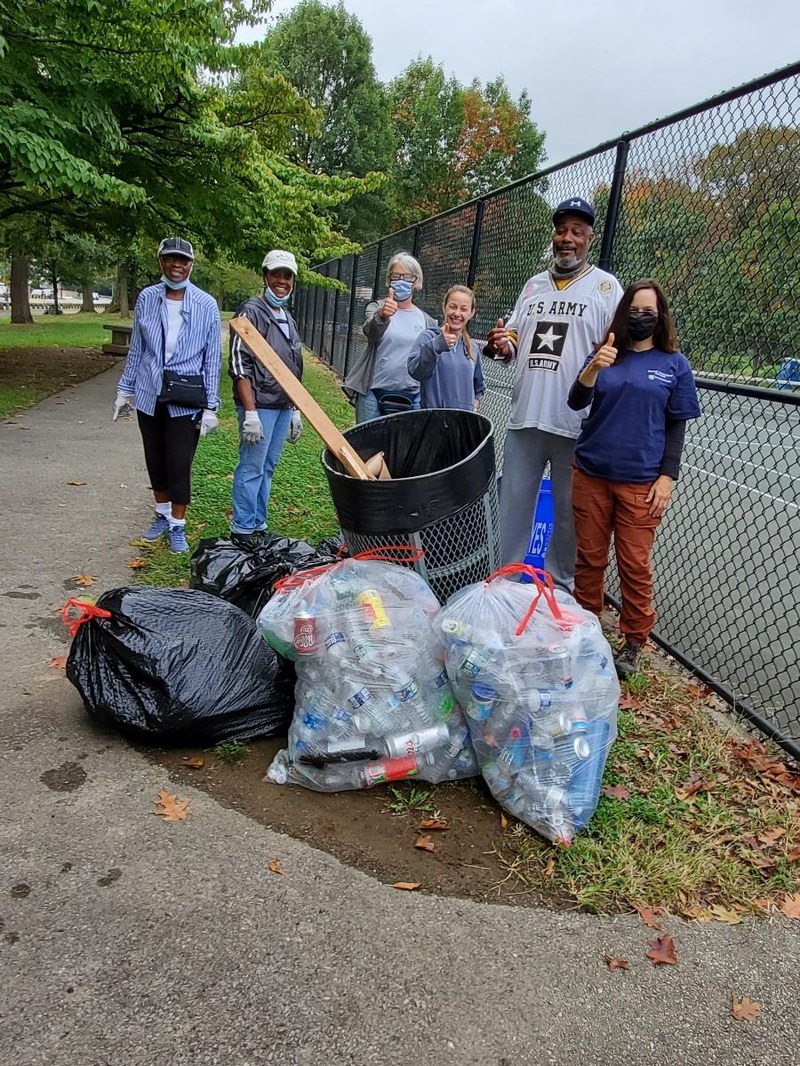Posted: October 20, 2021
Penn State Extension's Master Watershed Steward program works with resident volunteers in rural and urban communities across Pennsylvania to effectively manage watersheds, addressing issues such as stormwater overflow and different sources of pollution.

Master Watershed volunteers plants a tree in an urban neighborhood
By Justine Lindemann and Effie Palacios
A watershed can be a somewhat abstract concept, especially in urbanized or urbanizing landscapes. A watershed is an area of land where the water from rivers, streams, snow packs, and groundwater drain into the same outlet, a larger body of water such as a bay. Watersheds often cover larger areas of land, including cities, and water systems in urban areas are not always visible. Streams and other waterways are often buried under pavement and concrete. That said, urban watershed management is essential to residents' health and wellbeing, to urban community safety (think about issues such as flooding, drinking water, and infrastructure safety), as well as to the sustainability and health of the waterways themselves. Because smaller waterways come together to drain into a common outlet, "downstream" health is heavily dependent on "upstream" stewardship. In other words, the overall health of the system is impacted by individual and community actions across the entire area.
Penn State Extension's Master Watershed Steward program works with resident volunteers in rural and urban communities across Pennsylvania to effectively manage watersheds, addressing issues such as stormwater overflow and different sources of pollution. Beth Yount and Justin Mansberger—Master Watershed Steward Coordinators— both emphasize the critical role that Penn State Extension plays in bridging the gap between individual problems and larger scale (community- or society-wide) causes and solutions. This is especially important because community members often do not realize just how important watershed health is for their daily lives.
Beth Yount works in Philadelphia County (pop. 1.58 million), which is a downstream nexus of several watersheds including the Delaware, Schuylkill, and the Wissahickon. Philadelphia recently experienced extreme flooding and stormwater overflows from Hurricane Ida. Justin Mansberger is a Master Watershed Educator based in Westmorland County, south and a bit east of Allegheny County and the city of Pittsburgh, who works in three counties in the region. In contrast to Yount, Mansberger's work cuts across the urban-rural continuum, including in a series of small municipalities such as Greensburg (pop. 14,290), the Westmorland County seat.
In urban Pennsylvania, impervious surfaces create challenges to stormwater control, while pollution from industry, residences, construction, and businesses pose a threat to watershed health through contamination. Global climate change creates additional challenges for the management of these systems and to urban communities' capacity to thrive.

Yount and Mansberger argue that Extension is well-positioned to address watershed management in part because of its rootedness in communities. Both stress the necessity of "showing up" in the communities where they work, building relationships with residents as well as partner organizations, and getting to know the specific needs of those communities. In cities especially, it's important to work with communities in ways that "provide the ideal tools and systems and framework" to build more resilient urban systems. The complexity of urban issues makes collaboration on this work all the more important. Watershed management, especially post-flood remediation, demands knowledge well beyond hydrology, to include soil science, toxicology, city planning and civil engineering, and many other areas of focus.
For Mansberger, who has been working for PSE since spring of 2020, partnerships with conservation districts and watershed associations in his region have been critical to learning about the needs of communities and making connections with residents. Through these partnerships, he's "been able to develop those relationships and bounce ideas and share volunteer opportunities." Westmorland county and the surrounding counties have a mix of urban and rural landscapes, which demand different interventions in watershed stewardship. In more urbanized areas, such as Greensburg, Master Watershed Stewards work with homeowners to create more "watershed friendly properties," which includes planting natural grasses as part of a rain garden and installing rain barrels to capture stormwater.
Philadelphia County, where Yount works, represents a more extreme example of an urban watershed site. The demographic density, socio-economic and cultural complexity, and built environment of Philadelphia create unique physical, social, and cultural issues. Yount describes the challenges with extensive impervious surface cover of Philadelphia, saying, "We can put in lots of engineered and natural systems to try to increase the resilience and capacity of the land and water to take on that much storm overflow. But we can't match what we've taken away." The Wissahickon watershed, for example, encompasses 64 square miles (about twice the area of Manhattan) across Philadelphia and Montgomery counties and has a 44% impervious surface cover. According to Yount, in urban areas you "start to see noticeable effects on flooding (and) stormwater issues at around 20% impervious cover. By 30% you can have severe problems."
With over nine inches of rainfall in Philadelphia as a result of Hurricane Ida, flooding became a major problem for residents, especially those who live in basements or ground level dwellings. People who are impacted by the flooding don't necessarily have all the information they need to for post flood remediation. For example, "what (does) it mean for people if they have had the Delaware or Schuylkill River inundate their community garden, or their play space, or their work space?" Yount spends a lot of her time connecting people to each other and to available resources, including university professionals.
Dense urbanization and limited space make two of the "go-to" approaches to stormwater management - rain gardens and rain barrel storage - less accessible to many residents. The way that Penn State Extension approaches these issues should be sensitive to that unique context. For example, Philadelphia faces low rates of homeownership; materials should address both homeowners and renters, who might be hesitant to make substantial changes where they live. Finally, the county of Philadelphia is home to an extremely diverse population speaking an array of languages. Spanish, Chinese, Vietnamese, Russian, French Creole, Arabic, and many others are spoken by over 23% of residents at home. Penn State Extension translates some educational materials into Spanish to reach a wider audience, but many programs do not yet have Spanish language materials.
In Yount's view, Penn State Extension still has work to do to address the unique needs of urban residents, but she is trying to spur innovation. For example, her team is promoting downspout planters to replace home gardens and rain barrels in communities that don't have complete control over their green space. Extension focuses on providing "fact-based and responsive" data, such as mapping urban soils and educating residents about the levels of post-flood risk based on where they live. She is hoping to have her watershed stewards do an on-the-ground "citizen science" project; taking pictures and video to map communities in a way that would create useful information for flood prevention and post-flood remediation. Most recently, Yount wrote a grant with the Friends of FDR Park to further expand their work outside of individual homes and into communal space. FDR Park is a natural marshland ecology that has been repeatedly drained over time to build recreational spaces such as golf courses. This grant will support work to rewild and revegetate green spaces and to stabilize the bank edge of a large lake in the park.
For Philadelphia residents still reeling from Hurricane Ida, adaptive measures aimed at resilience building are well-received but often daunting in scope. Breaking down large-scale issues into bite-sized, small-scale pieces is central to community resilience. The central message to community members that Yount works with is one of scalability and visibility.
"[I want to] just let people know the good things that are happening in their city because a lot of times people feel kind of depressed about the tough things that are happening, especially right now. And there are so many bright lights that people aren't aware of."
Her view is that if residents are made aware of the immediate actions they can take - no matter how small - they will feel empowered to participate in community-level change.
Photos provided by Beth Yount.
If you would like to receive The Urban Resilience Report in your inbox, please click here to join the listserv.

